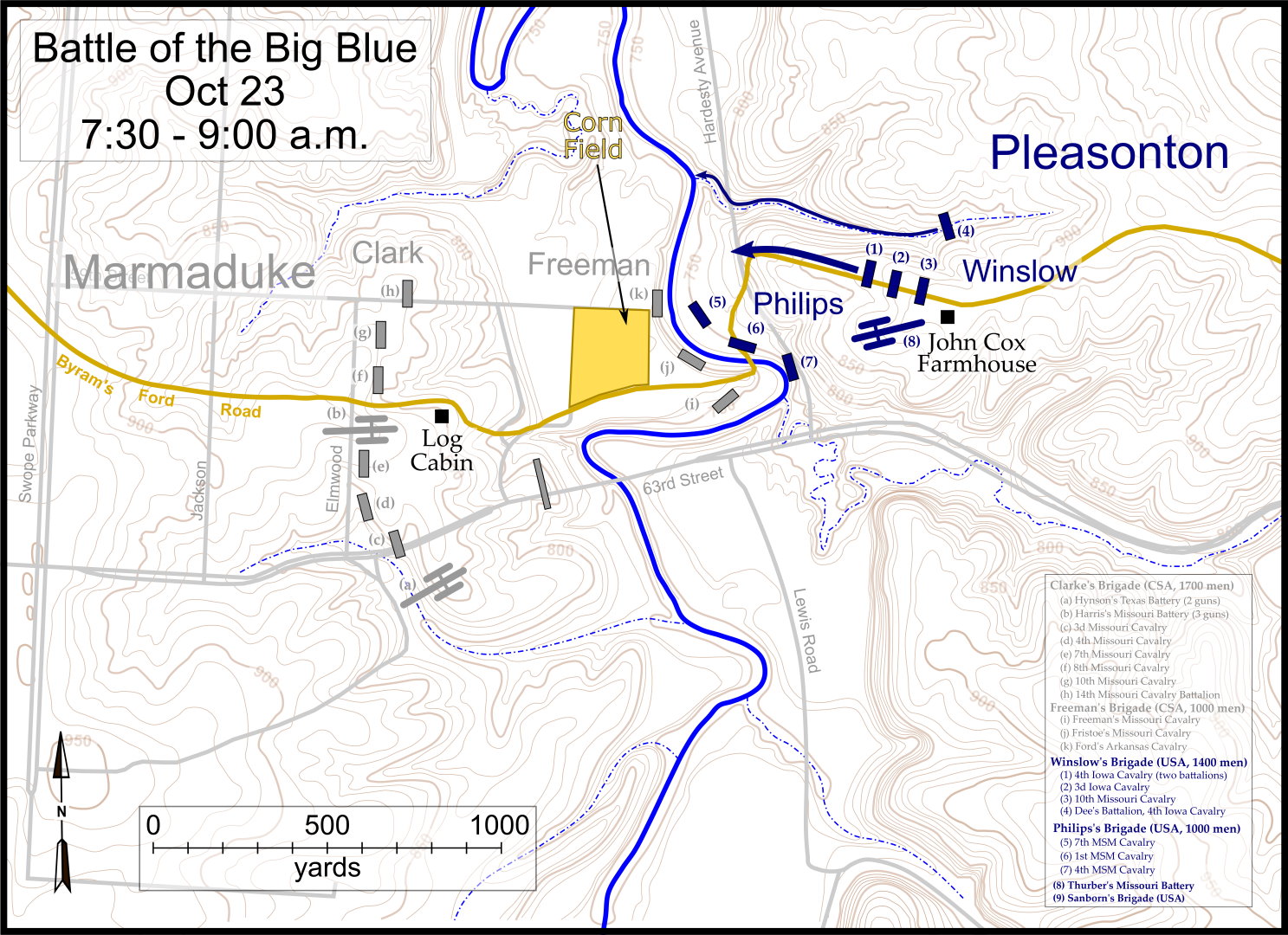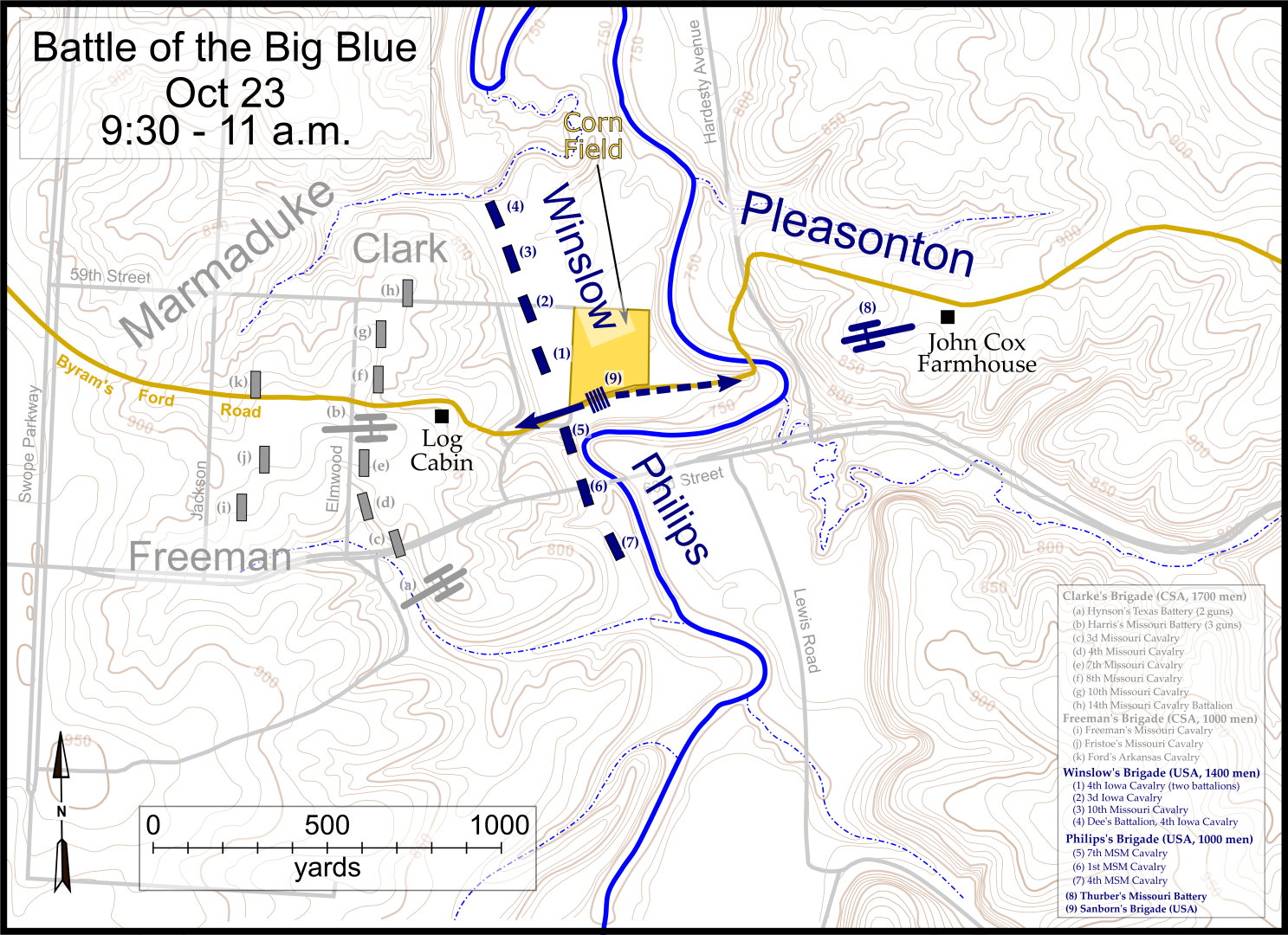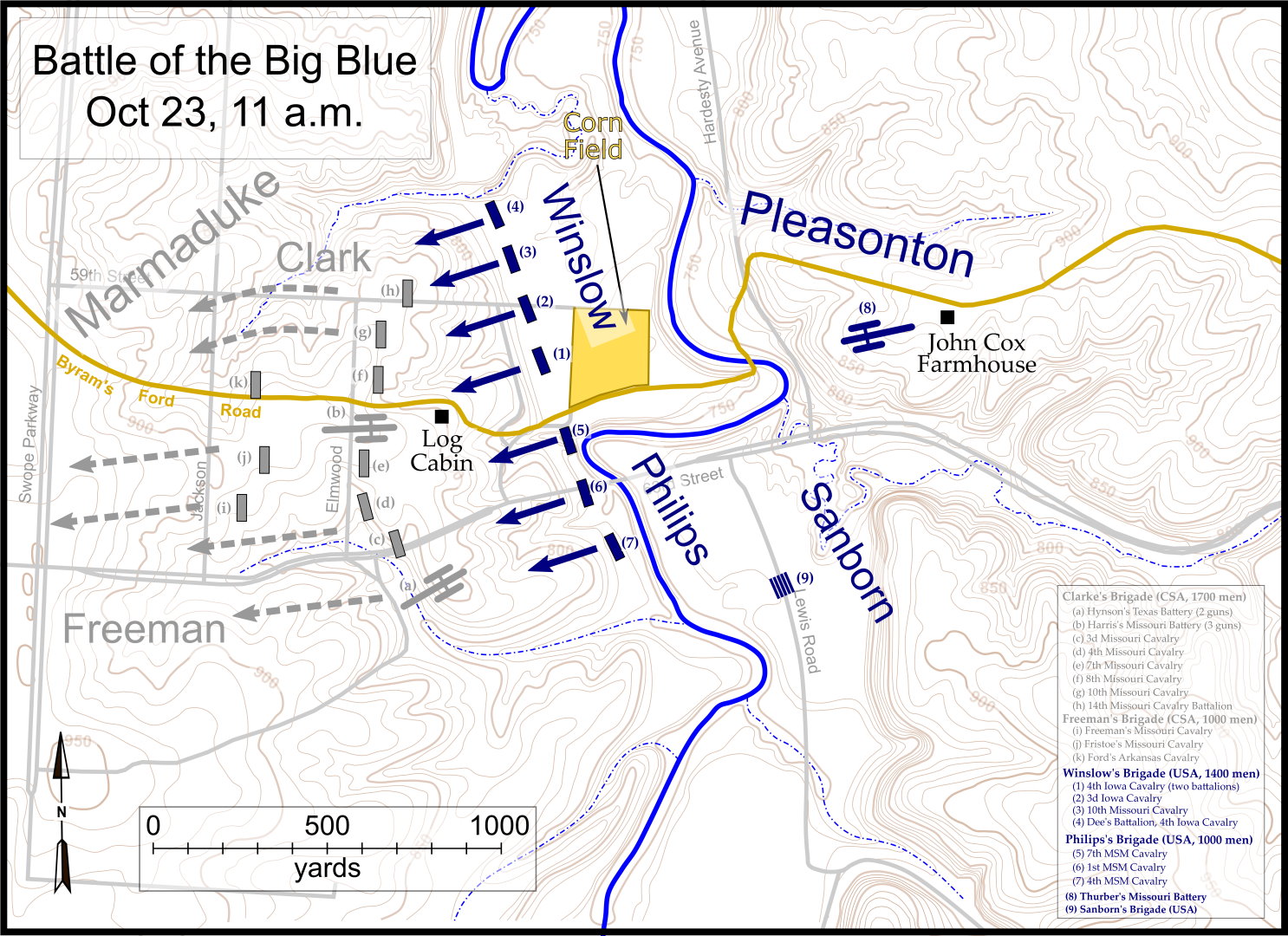
Scroll down for battlefield maps showing troop positions.
Scroll down for the text to follow along with the audio.
Click on the image to read a biographical sketch.



Maj. Gen. Alfred Pleasonton, Provisional Cavalry Division, Department of the Missouri
Maj. Gen. John S. Marmaduke, Marmaduke's Division, Army of Missouri
Col. Thomas R. Freeman, Freeman's Brigade, Marmaduke's Division
Brig. Gen. John B. Clark Jr, Marmaduke's Brigade, Marmaduke's Division
Brig. Gen. Egbert B. Brown, 1st Brigade, Provisional Cavalry Division
Col. John F. Philips, 7th Missouri State Militia Cavalry
Col. Edward F. Winslow, 4th Brigade, Provisional Cavalry Division
Lt. Col. Thomas T. Crittenden, 7th Missouri State Militia Cavalry
Brig. Gen. John B. Sanborn, 3d Brigade, Provisional Cavalry Division
Earlier today, Union cavalry forces under the command of Maj. Gen. Alfred Pleasonton defeated the Confederates under the command of Maj. Gen. John S. Marmaduke.
General Marmaduke occupied the defenses on the west bank of the Big Blue River at Byram’s Ford. Marmaduke’s objective was to hold off Pleasonton’s attack until the Confederate wagon train reached New Santa Fe and was out of harm’s way. The Confederate general deployed Col. Thomas R. Freeman’s brigade in a skirmish line on the west riverbank. Brig. Gen. John B. Clark Jr’s brigade was deployed about a half mile west of the ford on the high ground astride the Byram’s Ford Road. Also on the high ground were two artillery batteries under the command of Maj. Joseph H. Pratt.
After his victory in Independence yesterday, General Pleasonton was keen on pressing the attack. Pleasonton ordered Brig. Gen. Egbert B. Brown to take the 1st Brigade and attack at Byram’s Ford first thing Sunday morning.
There was just one small problem. The 1st Brigade was not at the head of the Federal column; Winslow’s 4th Brigade was. So, when they tried to switch positions, everything got all jumbled up. It was around 8:00 a.m. when Pleasonton realized it was too quiet, so he rode to the front to find out what was going on. He became enraged when he discovered his orders to attack had not been carried out. Pleasonton placed Brown under arrest and sent him to the rear. Brown objected but obeyed the order and removed himself from the battlefield. Pleasonton then elevated Col. John F. Philips, 7th Missouri State Militia (MSM) Cavalry, to command of the 1st Brigade and ordered him to “take charge of this entire brigade and go down there and put those people out.” He ordered Col. Edward F. Winslow to take overall command of the attack.
Artillery from Battery L, 2d Missouri Light Artillery, Capt. Charles H. Thurber commanding, was deployed on the high ground east of the river, easily in range of the Confederates. But the Federal artillery was also within range of the Confederate artillery across the way.
Philips ordered his men to dismount and move down the road toward Byram’s Ford. As they moved down the hill, they came under fire from the Confederate artillery to the west. The 7th MSM Cavalry, Lt. Col. Thomas T. Crittenden commanding, took the lead, followed by Lt. Col. Bazel Lazear with the 1st MSM Cavalry while Maj. George W. Kelly with the 4th MSM Cavalry brought up the rear. The rough terrain would have made it difficult for the 1st Brigade to maintain its lines as the men moved down the hill toward the river.
The initial attack by Colonel Philips’s Brigade stalled at the ford, so Colonel Winslow moved his brigade forward to reinforce the Federal attack. At the same time Winslow sent the 3d battalion from the 4th Iowa Cavalry commanded by Capt. Edward W. Dee around to the right to get across the river and flank the Confederate skirmish line on the west bank pf the river. The troopers in Dee’s Battalion were screened from view by the trees and a deep ravine. They crossed over and attacked the Confederate’s left flank forcing them to withdraw back to their main defense line. This took some of the pressure off the got across the river.
Philips moved his brigade forward under heavy fire until they came to a halt in a ravine on the left side of the Byram’s Ford Road. Colonel Winslow, also under heavy fire, moved his brigade to the base of a rock ledge on the right side of the road. Winslow sent word back to General Pleasonton to have the Union artillery shell the Confederate positions on the hill.
While Winslow was getting ready to launch a coordinated attack against the Confederates on the hill, Brig. Gen. John B. Sanborn showed up saying he had orders from Pleasonton to charge up the road to break the Confederate defense line. In columns of fours, Sanborn’s cavalry charged up the Byram’s Ford Road and got hit with heavy small arms and artillery fire. They got no further than a hundred yards or so when they turned back and were out of the fight until later that afternoon.
It was around 11:00 a.m. when Winslow launched his attack with Philips’s Brigade coming out of the ravine on the left of the road and Winslow’s Brigade scrambling over the rock ledge and up the hill. There was fierce fighting on Bloody Hill, some hand-to-hand, before the Confederates began to pull out of their defensive positions and fall back toward the Harrisonville Road. After fighting for several hours, the Confederates were running low on ammunition, and Marmaduke ordered the withdrawal.
Monnett, Howard N. Action Before Westport, 1864. Boulder, CO: University Press of Colorado, 1995.
Sinisi, Kyle S. The Last Hurrah: Sterling Price’s Missouri Expedition of 1864. Lanham, MD: Rowman & Littlefield, 2016.
Titterington, Dick. The Battle of Westport, October 21–23, 1864: A Driving Tour of Battle Sites in Kansas City, Independence, and Northeastern Jackson County, Missouri. Overland Park, KS: Trans-Mississippi Musings Press, 2019.